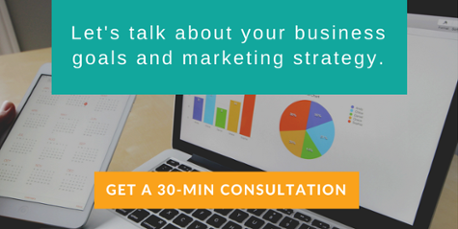
Social media. We all know it. We're all aware of how technology is changing the world we live in. It's crazy isn't it? There are more than two billion active social media users worldwide.
According to the Sensis Social Media Report findings from last year, "the uptake of social media by Australian businesses has grown in the last year". But how do we adapt to using social media for business growth?
You may be a social media coordinator, digital content producer or creative; or maybe you're in another role and your boss has given you the daunting task of posting on various social media channels such as Facebook, Instagram, Twitter and LinkedIn. Your mind starts racing as you try and think of some creative ideas on what you can post. And then all of a sudden, there it is, mind blank. At some stage we've all experienced these mind blanks.
So where do you begin with social media?
Step 1: Ask yourself what you want to achieve
Before you start thinking about creative content, you must ask yourself what you want to achieve using social media:
- What is your overall social media strategy?
- What is the purpose of posting on various social media channels?
- Do you want to increase the amount of followers you have?
- Do you want to increase traffic to your blog?
Create a SMART goal
Using the SMART goals framework is a great way to define what you want to achieve with social media:
Specific
Does your goal clearly define the type of growth that is expected from social media efforts?
Measurable
Do you have an exact number you want to reach?
Attainable
Do you believe that your goal is achievable?
Relevant
Is the goal relevant to the social media strategy?
Timely
Do you have an end date for the goal that you want to achieve?
Step 2: Understand the social platforms and your audience
Each social media platform is used differently and it is important to understand these differences:
- What is the main audience group?
- What types of social interactions is the platform used for?
- What privacy level is the norm?
- What types of content are preferred? Images, blog posts, articles, videos, infographics?
Know the social media platforms you will use
Facebook is used to connect with other users by updating your status and uploading photos and videos to your profile. You can also send messages and keep in touch with family, friends and colleagues.
LinkedIn is designed for professional networking and allows users to create a profile and market themselves to find a career that interests them. Users can also reach out to recruiters and others in different fields and share articles and their professional achievements.
Twitter allows users to post tweets (messages no more than 140 characters long) on any topic. Tweets are normally about an aspect of the user's life, links, images or matters that they find interesting, funny or that appeal to their followers.
Instagram is a photo and video sharing platform that allows users to share content with their followers. This social platform is intended for visual sharing. Users can keep track of who they're following and their own followers, and they can also directly message other users.
Pinterest is similar to Instagram in that it is about visual sharing. However, Pinterest allows users to upload, save, sort and organise images into categories using boards. Users can personalise content by pinning images onto their own boards.
Snapchat
Snapchat is a mobile app that allows users to send photos and images directly to their followers or post to their story. Every follower can view posts made to a user's story and these posts expire after one day. Users can see who has viewed their story and opened their direct snaps. Snapchat also offers a snap message feature where you can easily type a quick message to a follower.
Step 3: Create your social media content plan
This is where the fun begins. A social media content plan is a calendar that is used to map out what content will be posted when, on what channel and by whom. It will help your team to be consistent and meet your goals.
Before you create a content calendar, you need to come up with ideas for your social media posts. Keep your SMART goal and social media strategy in mind during your brainstorming sessions.
Brainstorm social media post ideas
Stand-up meetings
Stand-up meetings are a great way to connect with the whole team and share and discuss ideas as a group.
Post-it meetings
A post-it meeting allows each individual in the team to walk around individually and post post-it notes under different categories. An example of categories could be listing the various social media platforms and placing them around the room. That way each individual can place their post-it notes with their ideas under each category.
Design thinking
Design thinking is a customer-focused mindset concentrated on learning by doing. It entails solving problems and finding solutions by constantly experimenting and analysing. Design thinking can even involve interviewing people.
Make your own unique images
Canva is a simple graphic design tool that can be used to create presentations, posters, quotes and social media frames tailored towards different social media accounts. We definitely recommend it.
Stay updated with news and the latest trends
I'm sure we've all heard of the saying that one thing leads to another. Believe it or not you can gather ideas on content planning by staying updated with news and the latest trends.
Don't be too strict on your content planning. Sometimes experimenting will allow you to see what works and what doesn't.
Theme planner
If you find that you have a couple of different ideas you can create a theme planner. An example of a theme planner for Instagram could be posting a quote, an image of architecture and a group of people all on different days.
Hashtags
You can even experiment with creating your own simple hashtag that you would like your followers to use and base your content around that hashtag.
Step 4: Measure your social media metrics
Now you can finally take that big load off your shoulders. But before we finish up, there's one more very important step: measuring your success.
So how do you know how your social media content is performing? Three social media metrics you should analyse regularly are:
- Reach: the size of your audience
- Engagement: the number of interactions (likes and shares)
- Audience growth: the number of new followers
These metrics allow you to understand what your audience is engaging with the most.
Also keep in mind that the time that you post your content can affect the amount of users that engage with it. This is something that you can regularly keep track of. In general, the best times to post are in the morning or later in the afternoon as these times tend to be when users are most active.
There's a lot more to social media than keeping in touch with friends and sharing photos on our personal accounts. Social media is imperative for business growth. Understanding the different platforms and how they can be used is essential. Take a step back, think about your goals and start SMART.
Tags:
Marketing + Automation
February 22, 2017

